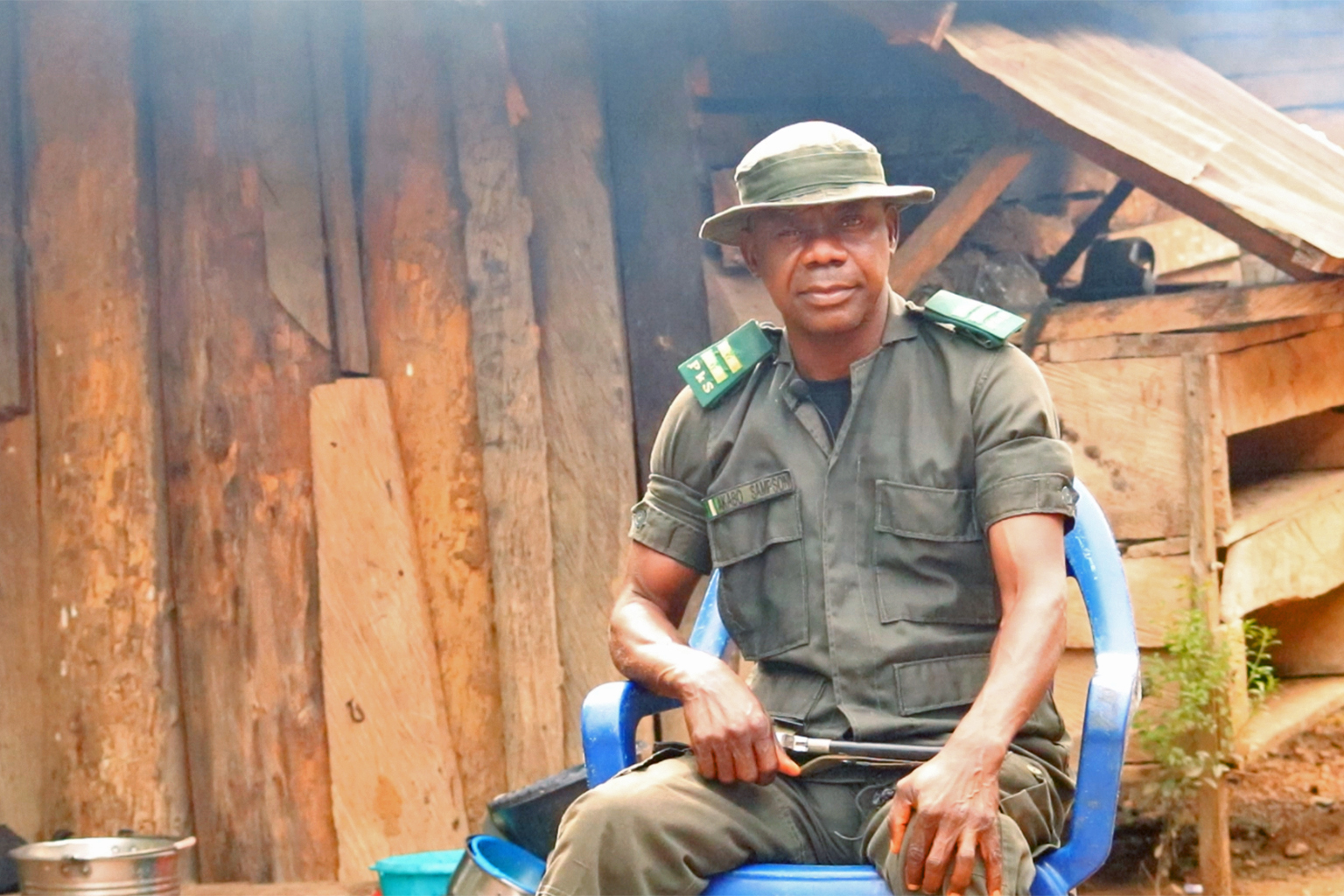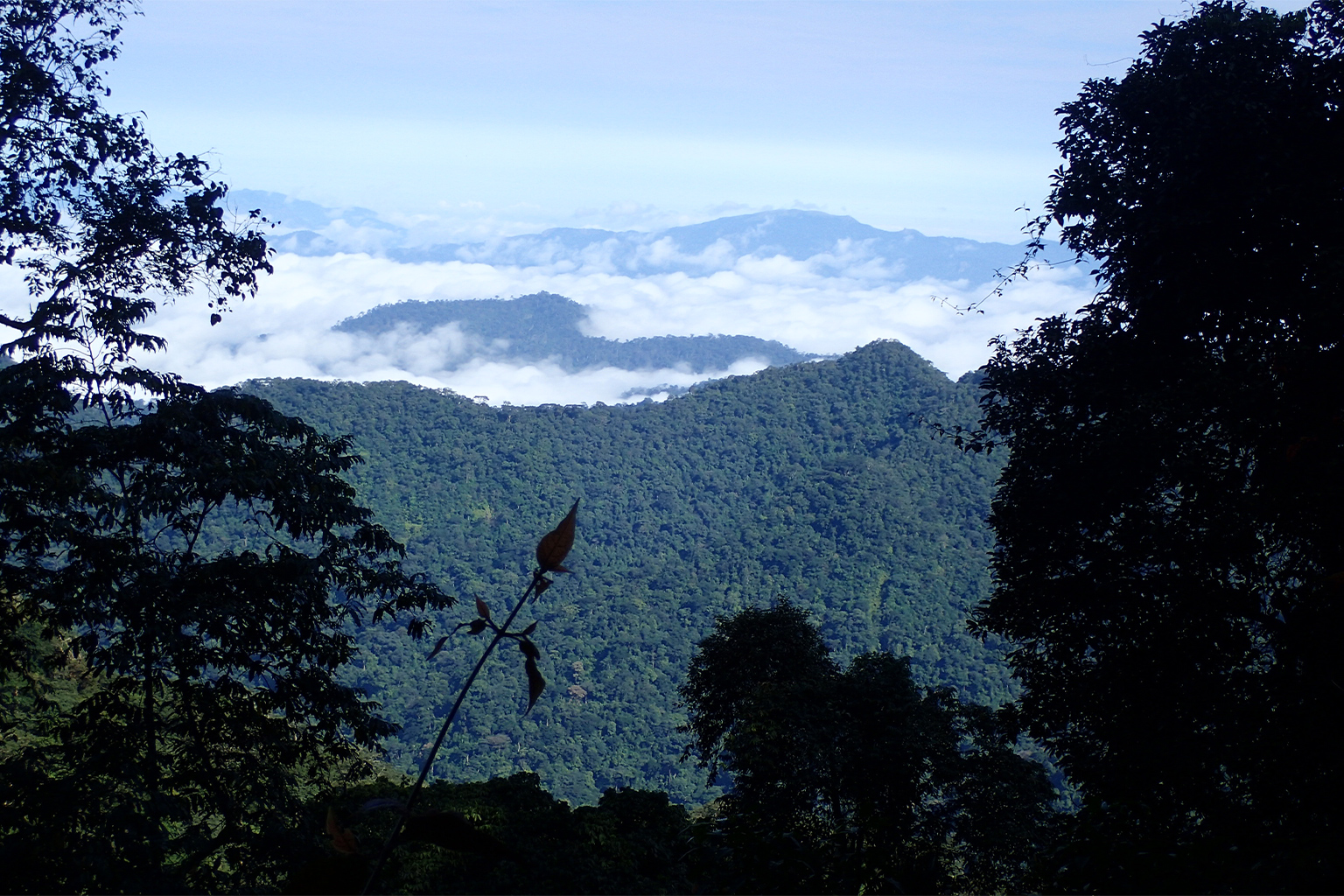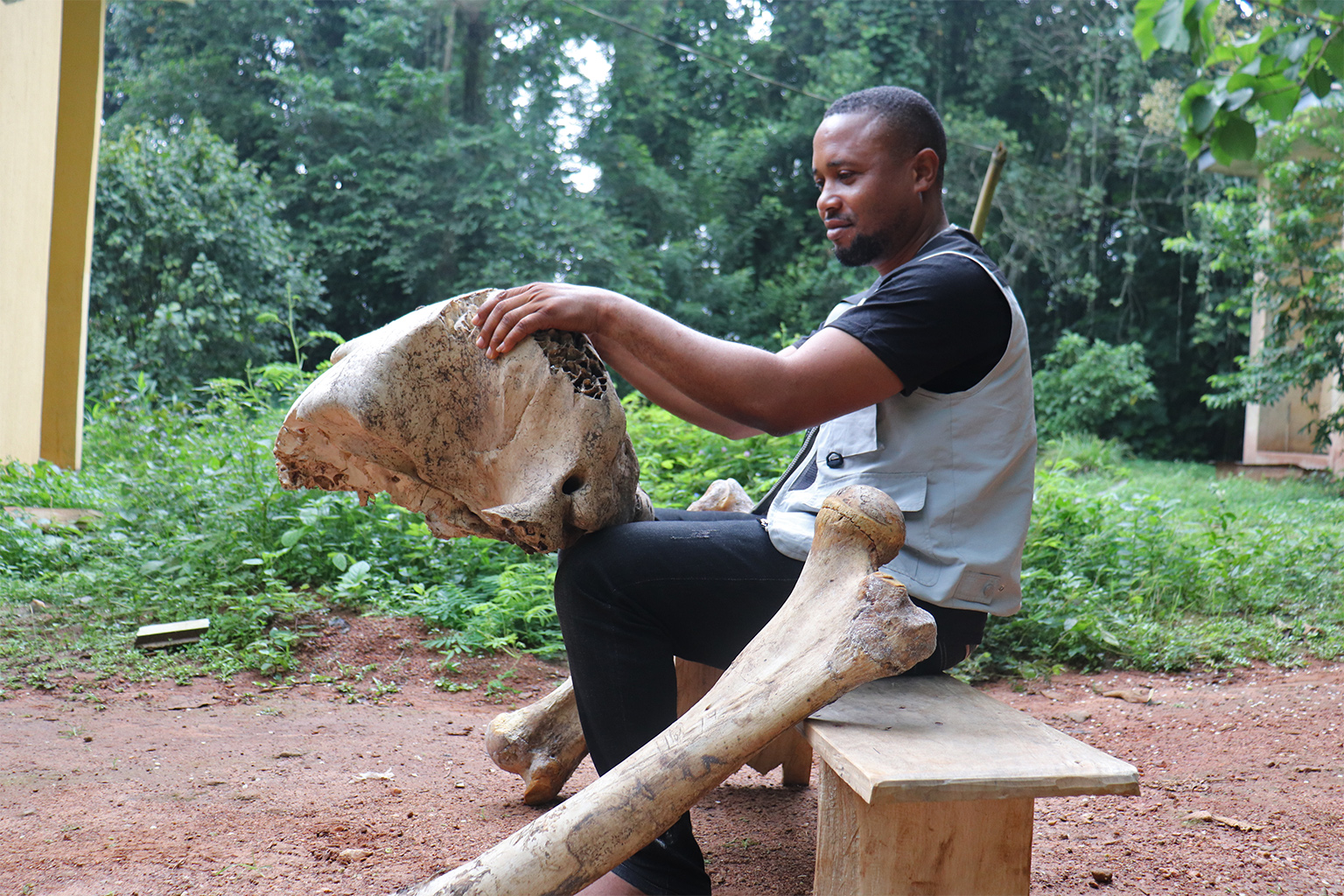- The rugged, isolated forests along the Nigeria-Cameroon border support a vast array of wildlife, including Cross River gorillas, Nigeria-Cameroon chimpanzees, and forest elephants.
- Historically, limited law enforcement in the border zone has left the ecosystem vulnerable to hunting and logging.
- Since the early 1990s, though, NGOs have been working alongside both governments to enhance transboundary conservation efforts, including joint patrols by rangers from both countries.
- This cross-border collaboration faces many obstacles today, including bureaucratic delays, treacherous terrain, armed poachers, and violent conflict in Cameroon, but participants remain optimistic about the potential for cooperation.
CROSS RIVER STATE, Nigeria — Sampson Akoba’s long career as a ranger has left him with a wealth of assorted memories: hunters’ revolts, the death of his nephew in a violent encounter with a Nigeria-Cameroon chimpanzee (Pan troglodytes ellioti), and the smoldering coals of campfires in the cold depths of Nigeria’s rainforest. Yet, he speaks of his participation in a joint Nigeria-Cameroon patrol as a defining moment.
This morning, Akoba sits on a plastic armchair, in a narrow corridor leading to a backyard and a wooden outdoor kitchen. “It was a lovely experience … a special patrol,” Akoba tells Mongabay as he stares at the curtain of fog and raindrops beyond his veranda in Butatong, a small farming community in Nigeria’s Cross River state.
The rugged, forested border between Nigeria and Cameroon was long neglected by officials, creating an opening exploited by elephant poachers, ape body part hunters, loggers and fishers. In the 1990s, however, conservationists and wildlife researchers began to focus more attention on the corridor, inspired by its biodiversity and its long-term value for conservation in the region. The research efforts, over time, matured into diverse forms of collaborations, including an occasional transboundary patrol.


In 2006, at the outset of the patrol program, Akoba joined a team of rangers from Nigeria’s National Park Service and a group of eco-guards from the contiguous Takamanda National Park (then a reserve) in Cameroon for a joint training led by the Wildlife Conservation Society (WCS). The training, he says, aimed to improve the physical condition of the rangers, their knowledge of emergency first aid, swimming skills, use of firearms, as well as combat skills for dealing with aggressive poachers and, later, the use of firearms.
Weeks later, the freshly trained joint patrol team destroyed dozens of hunting camps, recovered hunting rifles, arrested poachers, and intercepted fishers who had poisoned the rivers in the border territory. Old border markers, faded by years of disuse, and beacons buried in the forest bed, were retraced. Rangers recorded traces of forest elephants (Loxodonta cyclotis) moving and feeding, and signs of apes, especially the Cross River gorilla (Gorilla gorilla diehli).
Africa’s most endangered ape, with an estimated population of just 300 individuals, this gorilla subspecies is found in Afi Mountain Wildlife Sanctuary, Mbe Mountains Community Sanctuary, and the Okwangwo division of Cross River National Park and protected sites in neighboring Cameroon. On both sides of the border, the gorillas face pressure from hunting, logging and the bushmeat trade.
In addition to gorillas and elephants, this transboundary ecosystem is also home to endangered Nigeria-Cameroon chimpanzee, drills (Mandrillus leucophaeus), and other primates, forest buffalos, duikers and diverse trees and birds.
“For the first time, poachers realized that there is now law enforcement presence in the area,” Akoba says, reflecting on the impacts of the patrols. “And it made many of them limit their hunting activities. They knew it was now more risky to hunt animals around the border. We knew a lot of apes and elephants use that terrain.”


Ongoing efforts
Conservationists continue to explore means to reduce and counter threats to animals in the region, including workshops and surveys facilitated by NGOs and wildlife researchers, and sometimes involving both governments and their national parks agencies.
The efforts have improved intelligence sharing and transnational law enforcement between wildlife authorities in Nigeria and Cameroon. Exchange visits, complete with research, have been growing, as well as awareness and educational campaigns targeted at enclave communities on both sides of the border. Following a 2006 workshop, officials, researchers and NGOs settled on a priority action plan to improve national and cross border protection of apes in the region. This action plan has continuously been reviewed, taking fresh threats into account as well as shared interest and progress of the previous years.
“In the past, poachers kill animals in Cameroon and run to Nigeria to hide. Also, hunters who poach in Nigeria flee to Cameroon to hide,” says Akom Albert, a ranger with Nigeria’s National Park Service. For example, more than 20 illegal loggers recently arrested in Cameroon claimed to be Nigerians. The new system allows for the loggers to be prosecuted in Cameroon, the country where their alleged crimes were committed. The elevation of Takamanda Forest Reserve to a National Park in 2008 marked another milestone.
As is common with such cross-border collaborations, there have been rough patches, says Emmanual Bassey, WCS project coordinator in the Cross River landscape. Changes of government, along with broader political instability, have derailed some goals and projects. Parties, sometimes more keen on projecting national agendas, can sometimes approach negotiations and collective conservation actions with less vigor.
The biggest issue, sources say, is sorting out and signing paperwork, a process that can prove slow and complicated. Oluwole Ojewale of South Africa-based think tank the Institute for Security Studies attributes the paperwork drudgery partly to “lack of political will” and a mindset that looks upon the forest as a potential source of immediate profit.


Numerous local and international laws aimed at the protection of apes and related species are poorly enforced, he says. These flaws, along with corruption within law enforcement agencies, poor funding, and the proliferation of firearms, mean that threats to wildlife and timber in the border terrain remain high.
While administrative and political issues can stymie progress at the top, on-the-ground law enforcement faces its own set of obstacles. Rangers place their lives at risk trekking through tangled forests in the thick darkness and wading through swollen rivers. The border territories are a labyrinth of rivers and tributaries that often overflow during heavy rains. Bassey reports close brushes with death resulting from attempting to cross rivers while exhausted by long treks and heavy gear. Snakebites are equally a common threat, in forests that are home to cobras, mambas and vipers; some bites can be too much for regular antivenom to counteract. Exposure to rain and extreme cold can also contribute to rangers falling too sick to see out a patrol.
Handling these emergencies can be tricky. Nearby communities are often hours, if not days, away. Deciding to take a sick ranger or eco-guard to the nearest community invariably brings the patrol to a halt. In 2017, Bassey recalls, one of the rangers fell ill in the heart of the forest, only a few days into a patrol. He was vomiting became too week to walk. The patrol had to be called off and it took three days to get him to the nearest community, where he received preliminary medical care. “There are many such near-death experiences,” Bassey tells Mongabay.
Other times, the threats come from poachers, who either form alliances to resist arrest or collude with local communities to ambush patrol teams. Rangers can face pressure to surrender arrested poachers, a tactic that sometimes succeeds because the isolated nature of these locations makes calling in reinforcements nearly impossible. After a few such encounters with armed poachers and communities, both countries agreed to equip transboundary rangers with firearms to increase their chances of arresting aggressive poachers or at least escaping unhurt.

The Cameroonian crisis
It’s been more than three years since the last cross-border patrol was conducted, due to the ongoing political crisis in Cameroon. What started in 2018 as a low-key protest by teachers and lawyers from Cameroon’s English-speaking region, who complained of domination by their French-speaking compatriots, matured into a full-blown crisis in which more than 4,000 people have been killed and 760,000 displaced. Of the latter, around 60,000 fled to Nigeria through forest tracks, mountains and rivers.
Wildlife officials at several of Cameroon’s national parks fled at the outset of the crisis because separatists were known to target government institutions and their employees, says Eric Tah, deputy director of The Last Great Apes Organization (LAGA), an international NGO that supports the enforcement of wildlife laws in Cameroon. “None of the parks in the crisis area enjoys any sort of protection,” Tah says. Numerous foreign-funded conservation projects, at various degrees of execution, have been abandoned or temporarily suspended.
Tah says that with the vast numbers crossing through the forest to Nigeria, “wildlife must suffer.” Mongabay found that some of the refugees crossing over from Cameroon had settled in forest communities in Cross River, serving as cheap labor for loggers. Their survival is intricately linked to the forest as government support has been limited. There are also rumors that separatist fighters are using the forest, particularly parts that overlap with the gorilla range, as a haven.
While this news is troubling for conservationists, Tah says the biggest fear comes from the unknown: There is total information blackout from crucial conservation hotspots around Cameroon, especially in regions affected by the lingering crisis. “Nobody can say for sure whether separatist fighters are using the wildlife in those parks. It is impossible to return to work in those areas. Takamanda National Park, where we have the Cross River gorilla, is at the center of the crisis,” Tah says.
“If there is one species that might likely suffer the most because of the crisis, it has to be the Cross River gorilla,” he adds. “At the end of this crisis, we might not have any more Cross River gorillas in this country. We are very, very worried”
In 2020, Bassey of WCS and his team began mounting camera traps around the border region to get a sense of the activities of animals and poachers alike. “The camera traps caught three elephant poachers,” he says. After a follow-up investigation, WCS found that two of the three poachers, who had rifles, were Nigerians. The third person was probably a Cameroonian guide. The poachers probably attacked three elephants, of which two escaped with bullet wounds while one died. Bassey shows Mongabay the butchered skull of a baby elephant recovered during the investigation, saying that at least 10 elephants might have been killed in that area in the past year.
As the crisis festers, Tah says, gorillas on both sides of the border face increased risk of genetic isolation and inbreeding due to limited interactions between the subpopulations in Nigeria and Cameroon — a major fear for conservationists. As early as 2008, a study of genetic diversity among various types of gorillas found that Cross River gorillas had “lower levels of diversity” than the more numerous western lowland gorillas (Gorilla gorilla gorilla), and that genetic evidence suggested Cross River gorillas had recently gone through a genetic bottleneck, or rapid reduction in population size, that affected the species’ fitness.

World Heritage aspirations
Amid the chaos in Cameroon, both governments have continued to explore alternatives to keep some projects going through virtual interactions. More camera traps will now be deployed along the margins of Cross River National Park, toward the border areas, Bassey says.
WCS sources say talks are now underway to harmonize wildlife legislation and policies, and possibly form a unified central law enforcement unit with regional commands. There are also plans to expand livelihood support for communities living within the park’s boundaries, whose dependence on forest resources continues to deepen due to lack of jobs, poverty, and population growth.
However, the biggest aspiration for the future is to merge the major national parks where gorillas and chimpanzees occur into a single territory, elevated to a UNESCO World Heritage Site. A working group to facilitate the process, consisting of representatives from NGOs and both governments, has been meeting since 2016.
“The future looks good for our transboundary efforts. The level of commitment from both governments has been good,” says Inaoyom Imong, director of the Cross River landscape at WCS. When this is done, he adds, it will likely trigger more funding and support and urgency for conservation efforts in this region.
Banner image: A captive Cross River gorilla. On both sides of the Nigeria-Cameroon border, Africa’s most endangered ape faces pressure from hunting, logging and the bushmeat trade. Image by Julielangford via Wikimedia Commons (CC BY-SA 3.0).
FEEDBACK: Use this form to send a message to the author of this post. If you want to post a public comment, you can do that at the bottom of the page.
